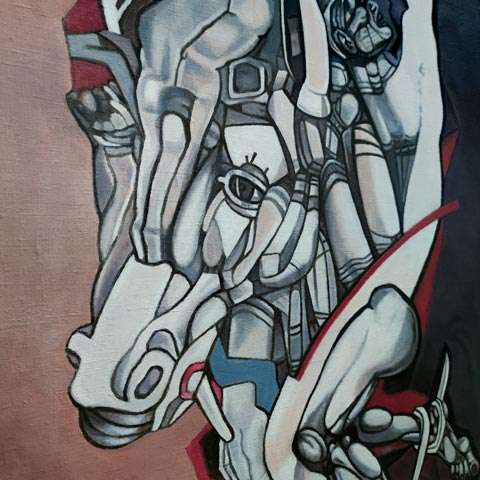
1960s UNOFFICIAL ART
NEIZVESTNY Ernst Iosifovich (1925–2016) Horseman. 1977. Oil on canvas. 90 × 70
The artist and sculptor Ernst Neizvestny is a lump of post-war unofficial art. He is the author of the 75-meter monument “Lotus Flower” in Egypt, “Masks of Sorrow” in Magadan, “Tree of Life” in Moscow and other outstanding works. The man was not only talented, but also uncompromising and amazingly courageous. Not shy neither before Khrushchev, nor the minister of state security. It was he who argued with Khrushchev at the Manezh in 1962, where Nikita Sergeevich suddenly declared that he was a Stalinist in the arts and that contemporary artists were doing “daubery”.
The work “Horseman” was painted in the first year of emigration. Horse, horse's skull, fetters on the rider's legs. The viewer has a great scope for interpretation. Much later a part of this work was embodied in the memorial “Exodus and Return”, installed in Elista. The authenticity of the work has been confirmed by Olga Neizvestnaya, the artist's daughter.
ZVEREV Anatoly Timofeevich (1931–1986) Mom in the kitchen. 1958. Paper, ink, oil. 38 × 57
Drawing by the legend of unofficial art and one of the most sought-after artists in our market. The work comes from the collection of George Costakis. And the burnt edges suggest that this sheet was once in the bundle of valuable drawings, saved from the fire from Costakis' country house in Bakovka. Before us is a melancholy and ironic story by Zverev about life in the Sokolniki communal apartment, with rats and other complicated everyday matters. The authenticity of the drawing is confirmed by the conclusion of Valery Silaev.
YAKOVLEV Vladimir Igorevich (1934–1998) Two white flowers. Late 1960s — early 1970s. Gouache, tempera on paper. 43 × 60
Vladimir Yakovlev. His most valuable subject of the most valuable period. Flowers, created at the turn of 1960–1970-ies. The fleeting beauty, fragility, drama. In the second half of his life Yakovlev almost completely lost his sight, worked, almost giving his face to a sheet of paper. He spent many years in psychiatric nursing homes. But the 1970s — it is still a young and full of strength Yakovlev, working with enthusiasm and inspiration. At this time, his best drawings appear.
The work is sold with the conclusion of Valery Silaev. At the same time, the expert notes the museum significance of the drawing.
BELENOK Petr Ivanovich (1938–1991) Attack. 1977. Hardboard, oil, collage, author's technique. 99 × 71
Panic realism in canonical execution. Particularly valuable period. Meter size. By all parameters Belenok of museum level. The painting “Attack” was created in 10 years after the successful Ukrainian sculptor Petr Belenok moved to Moscow. It was already a period of recognition. Belenok was exhibited abroad; Muscovites had already seen his paintings at high-profile exhibitions in the pavilions “Beekeeping” and “House of Culture” at VDNKh.
The construction of panic realism implies the conflict of man with the elements, with the unknowable. And these are usually scenes of escape. The little man tries to hide from the approaching abyss. But not in this case. In the painting “Attack” we don't see an act of submission, on the contrary, we see the resistance to the elements. Not with a grimace, but with a smile. There is an optimistic ending ahead— so rare in the artist's work. The painting has a strong provenance, published in catalogue 2021 and accompanied by an expert opinion. A find for the collector!
1970s UNOFFICIAL ART
PROVOTOROV Vladislav Alekseevich (1947) Melancholy. 1988. Oil on canvas. 92 × 65
The term “melancholy” was coined by the Greek physician Hippocrates. It comes from the Greek words “melas” (dark) and “choli” (anger or bile) — “black bile”, dark anger, a bad mood. Hippocrates believed that a gloomy state of mind was a symptom of illness. But now the term “depression” is used for melancholy in the former sense, and the word “melancholy” has come to mean just temporary despondency. And it is more likely even with romantic overtones. However, our painting is not about medicine at all.
Provotorov's “Melancholy” may be seen as a reference to the famous engraving of the same name by Albrecht Dürer, which is considered one of the most enigmatic works by the German Renaissance artist. According to one version, Dürer made not just an engraving, but an engraving of a charm — an instrument of banishing sorrow from the heart, expelling fears and doubts onto the pictorial plane. I would imagine that Vladislav Provotorov, a connoisseur and admirer of the German master's work, was engaged in a similar task.
In the 1970s, Vladislav Provotorov was an avant-garde artist with the city committee «Twenty» (which included Belenok, Kalinin, Kharitonov, and others). At that time, he, like many young independent artists, chose the path of spiritual search and “inner exile” — as a reaction to the surrounding hypocrisy of the era of stagnation. The language of his art is the imagery of the Apocalypse and the visualization of the physical destruction of human flesh in violation of moral principles. The destruction of the soul leads to the transformation of people into monsters. Sinners smolder on the move, turning into reptiles, losing their human appearance. And this imagery is fully realized in Provotorov's “Melancholy”.
Today Vladislav Provotorov serves as the rector of the Church of the Annunciation of the Blessed Virgin Mary in Pavlovskaya Sloboda village.
- Log in to post comments










